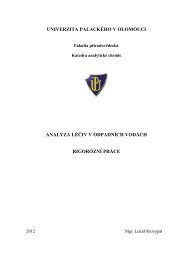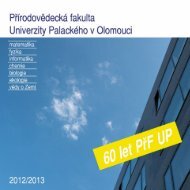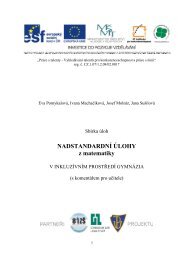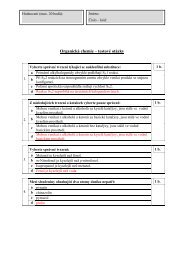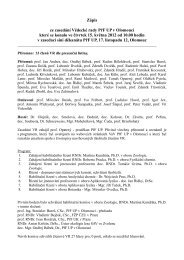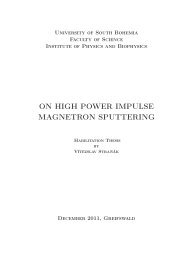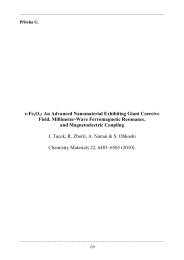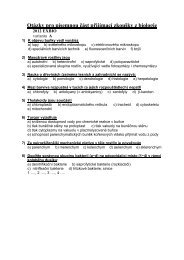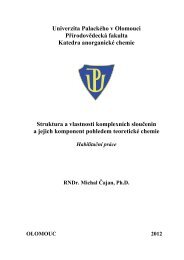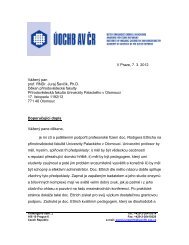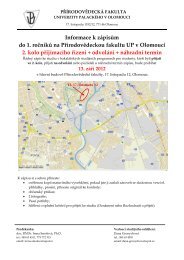A comparative structural analysis of direct and indirect shoot ...
A comparative structural analysis of direct and indirect shoot ...
A comparative structural analysis of direct and indirect shoot ...
Create successful ePaper yourself
Turn your PDF publications into a flip-book with our unique Google optimized e-Paper software.
M. OVECKA & M. BOB,4K<br />
Fig. 1. Scanning electron microscopy <strong>of</strong> critical point dried embryogenic tissue culture.<br />
a. Dividing activated ceils <strong>and</strong> somatic proembryos in clusters on the surface <strong>of</strong> embryogenic callus culture. Bar = 100 lain<br />
b. Asynchronously developing somatic proembryos (p), globular (g), heart-shaped (h) <strong>and</strong> torpedo (t) somatic embryos. Bar = 100<br />
lam<br />
c. Clustered secondary somatic embryos (arrows) originating from primary somatic embryo (E). Bar = 500 ~m<br />
d. External interconnecting strip-like <strong>and</strong> fibrillar "bridges" among individual proembryos within the cluster in early stages <strong>of</strong> regeneration.<br />
Bar = 10 ~am<br />
e. Surface cell wails were covered with continuous discrete layer, which partly disappeared into fibrillar network in the sites <strong>of</strong> cell<br />
separation (arrowheads). Bar = 10 lam<br />
f. Distinct mode <strong>of</strong> cell adhesion <strong>and</strong> cell separation between embryonic competent cells (A) <strong>and</strong> protodermal cells <strong>of</strong> globular somatic<br />
embryo (B). Embryonic cells were self-covered with tubular extension <strong>of</strong> the cell wall, which were absent on the surface <strong>of</strong><br />
the protodermis. Bar = 10 IJm<br />
g. Smooth protodermis <strong>of</strong> heart-shaped somatic embryo. Bar = 10 lam<br />
Fig. 2. Organogenic culture.<br />
a. Globular meristemoid shape supported by anticlinal (thick arrow) <strong>and</strong> periclinat (thin arrow) cell divisions <strong>of</strong> isodiametric cells.<br />
Mucilage layer (asterisk). Bar = 50 lam<br />
b. Transmission electron microscopy <strong>of</strong> peripheral meristemoid ceils. Note the apparently thicker outer "boundary" cell walls <strong>of</strong> the<br />
meristemoid with presence <strong>of</strong> wall-connecting elemental fibrils (arrows). Bar = 5 IJm<br />
c. Initial stages <strong>of</strong> globular meristemoid formation (arrows). Bar = 100 lam<br />
d. Synchrony in cell death <strong>of</strong> the senescing meristemoid. Bar = 100 Inn<br />
e. Two meristemoids surrounded by the dense amorphous mucilage. Bar = 50 lam<br />
f. Extent mucilage accumulation in the region <strong>of</strong> meristemoid senescence. Bar -- 100 lam<br />
g. Giant starch grains as a source <strong>of</strong> metabolic energy for future organogenesis in promeristemoid cells. Bar = 50 lam<br />
Fig. 3. Scanning electron microscopy <strong>of</strong> <strong>shoot</strong> regeneration.<br />
a. Developing <strong>shoot</strong> primordium (asterisk) between callus cells. Note the presence <strong>of</strong> fine layer <strong>of</strong> amorphous material on the cell<br />
surface (arrows). Bar = 100 lain<br />
b. Leaf <strong>of</strong> regenerated <strong>shoot</strong>. Bar = 100 lam<br />
c. Smooth surface <strong>of</strong> leaf epidermal <strong>and</strong> guard stomatal cells. Bar = I0 lam<br />
Fig. 4. Formation <strong>of</strong> intercellular spaces.<br />
a. Intercellular reticular structure in developing leaf tissue. Bar = 1 lam<br />
b. Reticular (R) <strong>and</strong> fibrillar (F) filling <strong>of</strong> intercellular space within the developed leaf parenchyma. Ch-chloroplast, V-central vacuole.<br />
Bar = 1 lam<br />
c, d. Light microscopy <strong>of</strong> serial section <strong>of</strong> critical point dried parenchymatic tissue in the region <strong>of</strong> vascular str<strong>and</strong>s <strong>of</strong> primary somatic<br />
embryo during secondary somatic embryogenesis. Extracellular fibrillar <strong>and</strong> reticular network was present in large intercellular<br />
spaces. The majority <strong>of</strong> PAS reaction-positive material occurred on the surface <strong>of</strong> cell walls (arrows). Bar = 50 lam.<br />
entiating somatic embryos were produced (Fig. lc).<br />
Detailed surface view shows fine structures covering<br />
individual proembryos, connecting them to<br />
each other (Fig. ld). Strip-like <strong>and</strong> fibrillar str<strong>and</strong>s<br />
bridged proembryos over distances among them<br />
continuing around the neighbouring "connected"<br />
proembryos. Strip-like bridges interconnected proembryos<br />
over longer distances <strong>and</strong> mostly fine fibrillar<br />
network covered tight, short distances (Fig.<br />
ld). Similar fibrillar network was found to interconnect<br />
surface proembryo ceils themselves continuing<br />
as a more or less coherent layer on the cell<br />
surface (Fig. le). The fine network could cover the<br />
proembryo itself probably since the first cell divisions<br />
(not shown), but single cells in embryogenic<br />
cluster were covered by long tubular extensions radiating<br />
from the surface <strong>of</strong> each globular cell (Fig.<br />
lf). Late globular somatic embryos where the pro-<br />
todermis have been established together with<br />
heart-shaped <strong>and</strong> torpedo somatic embryos with<br />
differentiated protodermis (Fig. lg) lacked completely<br />
tubular or fibrillar extensions <strong>of</strong> outer tangential<br />
cell walls (Figs. le, f) including fibrillar <strong>and</strong><br />
strip-like connections, which were observed among<br />
the proembryos (Fig. ld).<br />
Formation <strong>of</strong> globular meristemoids as a consequence<br />
<strong>of</strong> frequent mitotic division <strong>of</strong> activated<br />
cells took place during <strong>shoot</strong> organogenesis. Meristemoid<br />
cells achieved <strong>and</strong> propagated their globular<br />
appearance through periclinal, anticlinal <strong>and</strong> mixoriented<br />
cell divisions predominantly in the meristemoid<br />
periphery followed by isotropic cell expansion<br />
(Fig. 2a). Fibrillar network was not observed<br />
on the meristemoid surface (not shown), however<br />
peripheral cells expressed position-dependent<br />
assymetry in cell wall thickness. Thicker outer cell<br />
122




